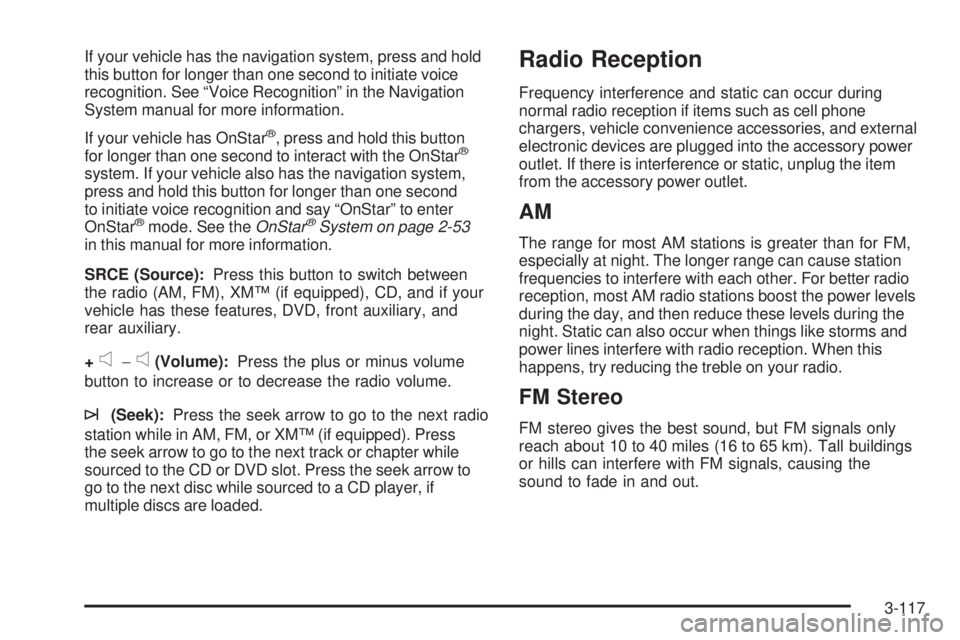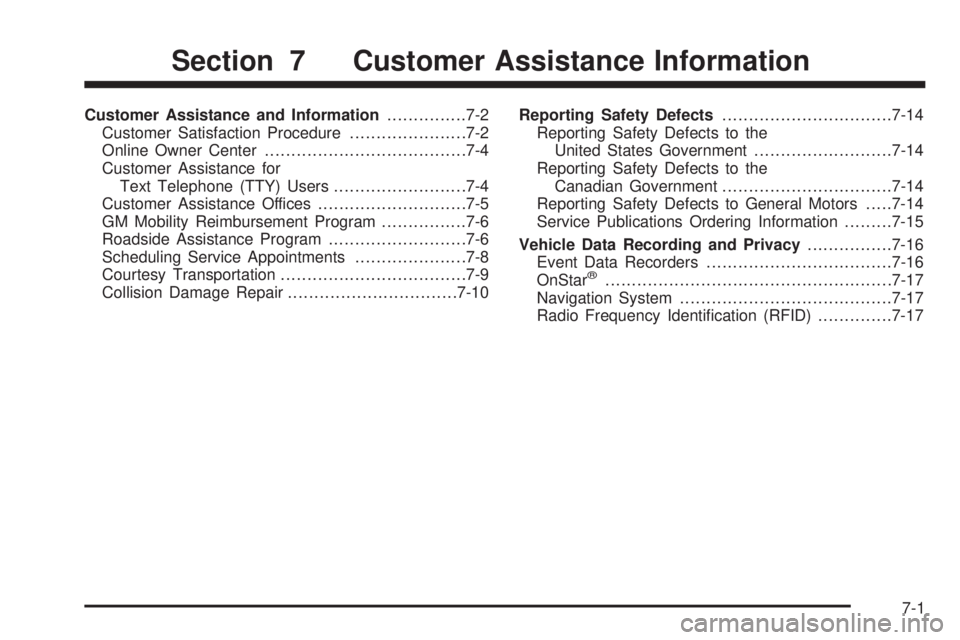2008 HUMMER H2 navigation system
[x] Cancel search: navigation systemPage 267 of 504

If your vehicle has the navigation system, press and hold
this button for longer than one second to initiate voice
recognition. See “Voice Recognition” in the Navigation
System manual for more information.
If your vehicle has OnStar
®, press and hold this button
for longer than one second to interact with the OnStar®
system. If your vehicle also has the navigation system,
press and hold this button for longer than one second
to initiate voice recognition and say “OnStar” to enter
OnStar
®mode. See theOnStar®System on page 2-53
in this manual for more information.
SRCE (Source):Press this button to switch between
the radio (AM, FM), XM™ (if equipped), CD, and if your
vehicle has these features, DVD, front auxiliary, and
rear auxiliary.
+
e−e(Volume):Press the plus or minus volume
button to increase or to decrease the radio volume.
¨(Seek):Press the seek arrow to go to the next radio
station while in AM, FM, or XM™ (if equipped). Press
the seek arrow to go to the next track or chapter while
sourced to the CD or DVD slot. Press the seek arrow to
go to the next disc while sourced to a CD player, if
multiple discs are loaded.
Radio Reception
Frequency interference and static can occur during
normal radio reception if items such as cell phone
chargers, vehicle convenience accessories, and external
electronic devices are plugged into the accessory power
outlet. If there is interference or static, unplug the item
from the accessory power outlet.
AM
The range for most AM stations is greater than for FM,
especially at night. The longer range can cause station
frequencies to interfere with each other. For better radio
reception, most AM radio stations boost the power levels
during the day, and then reduce these levels during the
night. Static can also occur when things like storms and
power lines interfere with radio reception. When this
happens, try reducing the treble on your radio.
FM Stereo
FM stereo gives the best sound, but FM signals only
reach about 10 to 40 miles (16 to 65 km). Tall buildings
or hills can interfere with FM signals, causing the
sound to fade in and out.
3-117
Page 473 of 504

Customer Assistance and Information...............7-2
Customer Satisfaction Procedure......................7-2
Online Owner Center......................................7-4
Customer Assistance for
Text Telephone (TTY) Users.........................7-4
Customer Assistance Offices............................7-5
GM Mobility Reimbursement Program................7-6
Roadside Assistance Program..........................7-6
Scheduling Service Appointments.....................7-8
Courtesy Transportation...................................7-9
Collision Damage Repair................................7-10Reporting Safety Defects................................7-14
Reporting Safety Defects to the
United States Government..........................7-14
Reporting Safety Defects to the
Canadian Government................................7-14
Reporting Safety Defects to General Motors.....7-14
Service Publications Ordering Information.........7-15
Vehicle Data Recording and Privacy................7-16
Event Data Recorders...................................7-16
OnStar
®......................................................7-17
Navigation System........................................7-17
Radio Frequency Identi�cation (RFID)..............7-17
Section 7 Customer Assistance Information
7-1
Page 489 of 504

GM will not access this data or share it with others
except: with the consent of the vehicle owner or, if the
vehicle is leased, with the consent of the lessee; in
response to an official request of police or similar
government office; as part of GM’s defense of litigation
through the discovery process; or, as required by
law. Data that GM collects or receives may also be used
for GM research needs or may be made available to
others for research purposes, where a need is shown
and the data is not tied to a speci�c vehicle or
vehicle owner.
OnStar®
If your vehicle has OnStar and you subscribe to the
OnStar services, please refer to the OnStar Terms and
Conditions for information on data collection and
use. See alsoOnStar
®System on page 2-53in this
manual for more information.
Navigation System
If your vehicle has a navigation system, use of the
system may result in the storage of destinations,
addresses, telephone numbers, and other trip
information. Refer to the navigation system operating
manual for information on stored data and for deletion
instructions.
Radio Frequency
Identi�cation (RFID)
RFID technology is used in some vehicles for functions
such as tire pressure monitoring and ignition system
security, as well as in connection with conveniences
such as key fobs for remote door locking/unlocking and
starting, and in-vehicle transmitters for garage door
openers. RFID technology in GM vehicles does not use
or record personal information or link with any other
GM system containing personal information.
7-17
Page 491 of 504

A
Accessories and Modi�cations............................ 5-3
Adding Equipment to Your
Airbag-Equipped Vehicle...............................1-75
Additives, Fuel................................................. 5-6
Add-On Electrical Equipment...........................5-110
Air Cleaner/Filter, Engine.................................5-18
Air Conditioning..............................................3-22
Airbag
Off Light.....................................................3-35
Readiness Light..........................................3-34
Airbag System................................................1-64
What Will You See After an Airbag In�ates?....1-70
When Should an Airbag In�ate?....................1-69
Where Are the Airbags?...............................1-66
Airbag Systems
Adding Equipment to Your
Airbag-Equipped Vehicle............................1-75
Airbag Off Switch........................................1-72
How Does an Airbag Restrain?......................1-70
Servicing Your Airbag-Equipped Vehicle..........1-75
What Makes an Airbag In�ate?......................1-70
Analog Clock..................................................3-21
Antenna, Fixed Mast......................................3-118
Antenna, XM™ Satellite Radio Antenna
System.....................................................3-118
Antilock Brake System (ABS)............................. 4-4
Antilock Brake, System Warning Light................3-39Appearance Care
Aluminum Wheels......................................5-106
Care of Safety Belts...................................5-103
Chemical Paint Spotting..............................5-107
Cleaning Exterior Lamps/Lenses..................5-104
Fabric/Carpet............................................5-101
Finish Care...............................................5-104
Finish Damage..........................................5-107
Instrument Panel, Vinyl, and Other
Plastic Surfaces.....................................5-102
Interior Cleaning........................................5-100
Leather....................................................5-102
Sheet Metal Damage
..................................5-106
Speaker Covers.........................................5-103
Tires........................................................5-106
Underbody Maintenance.............................5-107
Vehicle Care/Appearance Materials...............5-108
Washing Your Vehicle.................................5-103
Weatherstrips............................................5-103
Windshield, Backglass, and Wiper Blades......5-105
Wood Panels............................................5-103
Appointments, Scheduling Service....................... 7-8
Ashtray.........................................................3-21
Assist Steps...................................................4-32
Audio System.................................................3-72
Audio Steering Wheel Controls....................3-116
Fixed Mast Antenna...................................3-118
Navigation/Radio System,
see Navigation Manual............................3-104
1
Page 498 of 504

Lockout Protection..........................................2-12
Locks
Delayed Locking..........................................2-11
Door..........................................................2-10
Lockout Protection.......................................2-12
Power Door................................................2-11
Programmable Automatic Door Locks.............2-11
Rear Door Security Locks.............................2-12
Loss of Control...............................................4-12
Low Fuel Warning Light...................................3-48
Luggage Carrier..............................................2-65
Lumbar
Power Controls............................................. 1-3
M
Maintenance Schedule
Additional Required Services........................... 6-6
At Each Fuel Fill........................................... 6-9
At Least Once a Month.................................. 6-9
At Least Once a Year..................................6-10
Introduction.................................................. 6-2
Maintenance Footnotes.................................. 6-7
Maintenance Record....................................6-16
Maintenance Replacement Parts....................6-14
Maintenance Requirements............................. 6-2
Owner Checks and Services........................... 6-8Maintenance Schedule (cont.)
Recommended Fluids and Lubricants.............6-12
Scheduled Maintenance................................. 6-4
Using.......................................................... 6-2
Your Vehicle and the Environment................... 6-2
Malfunction Indicator Light................................3-42
Manual, Using.................................................... iii
Memory Seat and Mirrors.................................. 1-4
Message
DIC Warnings and Messages........................3-56
Midgate
®.......................................................2-14
Mirrors
Automatic Dimming Rearview with Compass
and Temperature Display...........................2-45
Outside Automatic Dimming Mirror.................2-49
Outside Convex Mirror.................................2-49
Outside Heated Mirrors................................2-49
Outside Power Foldaway Mirrors....................2-48
MP3 .....................................................3-94, 3-98
MyGMLink.com................................................ 7-4
N
Navigation System, Privacy..............................7-17
Navigation/Radio System,
see Navigation Manual...............................3-104
New Vehicle Break-In......................................2-28
8
Page 499 of 504

O
Odometer......................................................3-33
Odometer, Trip...............................................3-33
Off-Road Driving.............................................4-13
Off-Road Recovery..........................................4-11
Oil
Engine.......................................................5-13
Pressure Gage............................................3-45
Pressure Light.............................................3-46
Oil, Engine Oil Life System..............................5-16
Older Children, Restraints................................1-36
Online Owner Center........................................ 7-4
OnStar, Privacy..............................................7-17
OnStar
®System, see OnStar®Manual...............2-53
Operation, Universal Home Remote System........2-57
Other Warning Devices...................................... 3-6
Outlet Adjustment............................................3-29
Outlets
Accessory Power.........................................3-20
Outside
Automatic Dimming Mirror.............................2-49
Convex Mirror.............................................2-49
Heated Mirrors............................................2-49
Power Foldaway Mirrors...............................2-48
Overheated Engine Protection Operating Mode....5-28
Owner Checks and Services.............................. 6-8
Owners, Canadian............................................... ii
P
Paint, Damage..............................................5-107
Park Aid........................................................2-50
Park Brake....................................................2-40
Park (P)
Shifting Into................................................2-41
Shifting Out of............................................2-42
Parking
Over Things That Burn.................................2-43
Passing.........................................................4-12
PASS-Key
®III+..............................................2-26
PASS-Key®III+ Operation................................2-26
Perchlorate Materials Requirements, California...... 5-4
Power
Door Locks.................................................2-11
Electrical System.......................................5-110
Lumbar Controls........................................... 1-3
Reclining Seatbacks...................................... 1-5
Retained Accessory (RAP)............................2-29
Seat............................................................ 1-2
Steering Fluid.............................................5-34
Windows....................................................2-20
Power Winch Platform.....................................4-43
Privacy..........................................................7-16
Event Data Recorders..................................7-16
Navigation System.......................................7-17
OnStar.......................................................7-17
Radio Frequency Identi�cation.......................7-17
Programmable Automatic Door Locks.................2-11
9
Page 500 of 504

R
Radio Frequency Identi�cation (RFID), Privacy....7-17
Radios..........................................................3-72
Radio(s)........................................................3-75
Radios
Navigation/Radio System,
see Navigation Manual............................3-104
Rear Seat Audio........................................3-114
Reception.................................................3-117
Setting the Clock.........................................3-73
Theft-Deterrent..........................................3-116
Reading Lamps..............................................3-19
Rear Air Conditioning and Heating System
and Electronic Climate Controls.....................3-29
Rear Axle......................................................5-45
Locking........................................................ 4-6
Rear Door Security Locks................................2-12
Rear Heated Seats........................................... 1-8
Rear Seat Armrest..........................................2-65
Rear Seat Audio (RSA)..................................3-114
Rear Seat Entertainment System.....................3-105
Rear Vision Camera........................................2-50
Rear Windshield Washer/Wiper.........................3-11
Rearview Mirror, Automatic Dimming with
Compass and Temperature Display................2-45
Reclining Seatbacks, Power............................... 1-5Recommended Fluids and Lubricants.................6-12
Recovery Loops..............................................4-40
Recreational Vehicle Towing.............................4-51
Remote Keyless Entry (RKE) System.................. 2-4
Remote Keyless Entry (RKE) System, Operation . . . 2-5
Remote Vehicle Start........................................ 2-8
Removing the Flat Tire and Installing
the Spare Tire.............................................5-88
Removing the Spare Tire and Tools...........5-80, 5-84
Replacement Bulbs.........................................5-53
Replacement Parts, Maintenance......................6-14
Reporting Safety Defects
Canadian Government..................................7-14
General Motors...........................................7-14
United States Government............................7-14
Restraint System Check
Checking the Restraint Systems....................1-76
Replacing Restraint System Parts
After a Crash..........................................1-77
Retained Accessory Power (RAP)......................2-29
Ride Height, Selectable Extended Rear Ride......4-53
Roadside
Assistance Program....................................... 7-6
Rocking Your Vehicle to Get it Out....................4-40
Routing, Engine Drive Belt...............................6-15
Running the Engine While Parked.....................2-44
10